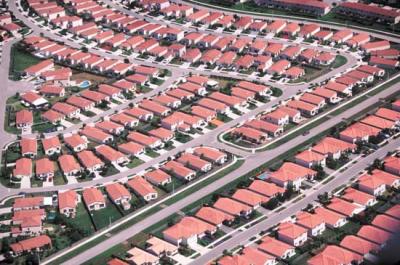So what do you get when you mix high transportation costs (high cost of gas) with falling home values (sub-prime mortgage debacle) I say you get the the prefect lens through which to view the folly of sprawl. Specifically suburbs and exburbs (think suburbs on steroids, with a wall around then, even father out in the middle of nowhere).
I was listening to NPR this morning about how housing values were falling all over, but not so much in places close to big cities. It seems that living near or in a big city still has value, while the mc-mansion suburb home values are dropping like flies.
Many people spend an hour or more a day commuting back and forth from their suburban home to their city job. Get up, get in the car, drive in traffic, find and pay for parking, work, fill up with gas because you burned it all in morning traffic, sit in afternoon traffic, get home late and exhausted, rinse and repeat. Does this sound like your life? Imagine if your work day could be something like this, get up, eat breakfast, walk two miles to work (or ride your bike), work, walk home, enjoy your evening. This could be the perfect time to move back towards a city center.
Living close to where you work has the added benefit of allowing you to go home for lunch, keeping you healthy (all that walking/riding is good for the love handles), keeps money in your pocket and carbon out of the air (less car rides). Not to mention the mental savings of not having to sit in traffic all that time. Living in a sustainable but dense way leads to a lot of cultural and ecological and economic benefits. Not to mention the fact that it leaves more of nature free to be well, natural.
The growth of suburbs happened right along with the growth of large national highway systems (at the expensive of rail traffic, something I am a fan of). They also saw the emptying out of our city centers of mostly white rich people, leading to slums, self imposed segregation and a whole host of other unintended consequences.
This might have not seemed that bad (to some) when gas was cheap, and the earth wasn’t over heating. But now that our nations highways are crammed full of cars belching green house emissions into the air and our homes are 30 (or more) miles from ANYTHING well I think we got a little out of hand.
Could we be seeing the first stages in the inevitable death by neglect of the suburbs? What will an abandoned suburb look like? What do you think? Is this the beginning of the end for suburbs and sprawl?
(Bonus conversation starter: Would the deployment of cheap and renewably powered electric cars that had the same range as gas cars cause even more sprawl?)

I think we are a ways off from the ‘Death of the Burbs’ but we are getting closer. I also tend to think along the lines that it might be a slight deep in the Burbs so long as we get cleaner technologies like the electric car. With things as those there are always going to be people that are willing to put up with an hour drive and the stress that comes along with that.
This is currently what I get to deal with, although my drive is not too bad. It is only like 20 to 25 minutes on a good average day. If you toss in construction or traffic this is gets closer to the hour mark.
I myself have been reconsidering moving closer to the city as I am getting tired of all this crap and honestly I hate cars. They are nothing but a huge waste of money. Not saying that my wife and I could do without both of our cars, but if we could only have one that would be awesome. I would love nothing better than to be able to ride my bike to work!
I agree with Stephen that the ‘Burbs’ will likely be with us for a long time. However, I wonder if perhaps instead of people moving back to where the jobs are, the jobs will increasingly move toward the people?
As an example a major insurance company is headquartered in my city. The main complex is downtown, but probably an equal number of employees work in one of 2-3 large office buildings in a nice suburb about a 25 minute drive away.
As technology allows faster and faster communication across distances, perhaps the need for a “prime location” on Wall Street, in the Loop, or close to City Hall will begin to dissipate. Who knows, maybe suburbanites can have their cake and eat it too?